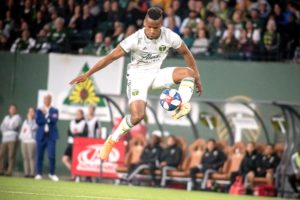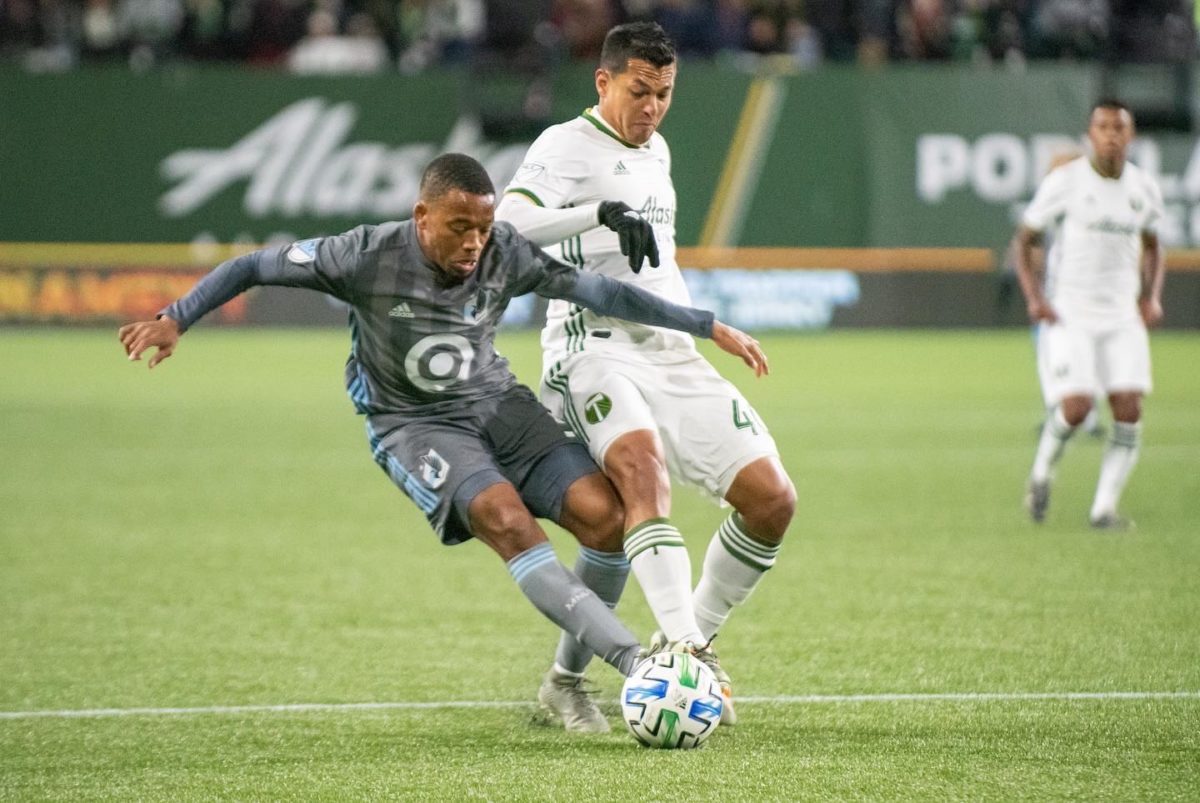The bright sun peeked out through the fog on another cold Pacific Northwest morning as the Portland Timbers’ first team entered the pitch for another day of training. On the outskirts of the field were the goalkeepers, already multiple drills into their practice. Field players were beginning to stretch on the opposite side of the field.
A few feet away from all of this is a fence, teasingly covered in black and tall enough to obscure any passersby from sneaking a peek directly at the practice field. On the other side of this fence is another pitch—that one, tantalizingly close, yet a world away, is where many young players begin their professional journeys for Timbers 2 (T2). This less-secluded field is where players continue their development, with the ultimate goal of becoming permanent fixtures at the practice field across the fence.
It’s been six years since T2 started, and as time has gone on, more and more players are beginning to make that very jump. Two seasons ago, forward Jeremy Ebobisse made the leap from the USL Championship side to the first team; last season, Marvin Loria, Eryk Williamson, and Renzo Zambrano followed. What makes T2 pivotal for player development is that the program is connected to the first team, allowing players to make the transition from the development academy or college to the professional level.
For Zambrano, a Venezuelan who had only played in Spanish-speaking countries, being a part of T2 allowed him to adjust to living in America and gain more confidence in himself as a player, all while receiving multiple opportunities to play game minutes.
“When I came from Spain, I had an injury,” Zambrano said, mostly in English with a little help of a translator. “So my focus was playing every single week in as many minutes as I could. The confidence the coaches gave me to be able to play, develop, and eventually make it to the first team was key.”
During May of last season, Zambrano received his first opportunity to play with the Timbers. Shortly after playing the Tacoma Defiance in the USL, Zambrano remembers being told by the coaching staff that he would be getting to start in a regular-season mid-week match against the Houston Dynamo.
“I prepared for that moment and worked very hard, because this is a very competitive squad and there are many players who want to be stars,” Zambrano said. “Obviously I knew that I had to take advantage of that opportunity and do the best I can, both in training and also in the games.”
While Zambrano needed to adapt to a whole new country, culture, and language; Williamson—a Virginia native—recalls the helpfulness of just having a designated place to develop and get minutes before making the jump to MLS.
“Right away, I learned what do I have to get out of a professional game, what do I have to do for ninety minutes, what do I have to do for the time I’m stepping on the field,” Williamson said. “I think that’s the biggest thing that I take from T2 games. Making sure that I am getting my job done, so when it is time to make that step, it’s repetition.”

Unlike most of the USL Championship, T2 is directly tied to an MLS side. Having that in Portland allows players and coaches at all levels of the organization to interact. Sometimes that interaction takes place in the cafeteria; other times, a first-team player might check out a game or training of the USL side.
“It’s pretty cool when they come say ‘Hi’ to you and ask you how you’re doing,” current T2 midfielder Carlos Anguiano said with a smile.
The close relationship between the two branches of the club benefited Williamson, who has been working closely with the Timbers’ video and data analyst, Shannon Murray, and assistant coach Miles Joseph over the past few years. The three often sit down and go over film. Williamson learns more about what the first team coaches want to see out of him, which helps him shape his game in the right direction.
Last June, the fitness staff advised Williamson to be ready in case he was needed on the first team, who were finishing up a hectic, road-heavy start to the season. A few days later, head coach Giovanni Savarese told him that he was going to start in the team’s mid-week match in Montreal, a testament to his hard work and performance for T2.
“It’s one of those things where you always have to be ready, whether it’s your chance or not,” Williamson said.
Yet, for as beneficial as T2 can be—and that’s the consensus—sometimes being a part of the second team is difficult for players, especially mentally. One player with mixed emotions from his time on T2 is current first-team striker Jeremy Ebobisse. Ebobisse, it can be argued, is the most successful player to come out of T2—he recently signed a contract extension with the first team—but his time in the USL was tumultuous.
In his first season with T2, Ebobisse played three games before being called up to the first team, where he trained but often sat on the bench during games. Later that season, he played in the US U-20 World Cup and returned only to play in a handful of T2’s remaining games.
“That [apparent] regression was challenging mentally, but ultimately going to play with T2 taught me that there’s a lot of responsibility on players that the club views as first-team guys for the future,” Ebobisse said. “If you do not live up to the standard of raising everyone else’s level, then ultimately you’re going to face consequences, and I faced probably the hardest and worst consequences where I found myself on the bench for T2 my second year right before breaking through. I think there are some hard lessons to learn, but through it all, it’s a unique place to have to grow. Obviously, you hope to bypass it, but if you have to spend a year or two there are lessons you can take out of it.”

An in-form start to the 2018 season was quickly derailed by multiple injuries, call-ups, and time on the bench, which made it almost impossible to establish any type of consistency until the season’s latter half. Coming into the organization with high expectations of himself, Ebobisse found the proximity to the first team more mentally challenging than he anticipated.
“This is just my personal opinion, but it’s almost detrimental to a player’s well-being if they are not mentally strong enough in that moment to know that there is a barrier separating where they belong, and the guys they see and train with most of the time and where they’re at,” Ebobisse said. “So when I am on the turf training for T2 and I see the first team having a competitive training and competing and laughing and yelling, I want to be a part of that. Sometimes adjusting to that position is challenging as well.”
But in a way, it was that proximity to the first team that ultimately benefited him. Ebobisse made some close friends in the Timbers locker room who continued to encourage him and helped him stay mentally engaged during the tough moments. In fact, it was Larrys Mabiala and Bill Tuiloma who told Ebobisse he would be getting his first regular-season start.
“I was at the stadium training, they saw the practice scheme and said ‘You’re starting this weekend, you better be ready. Are you ready?’ while laughing,” Ebobisse recalled. “I said ‘What are you guys talking about,’ and tried to downplay it in the moment like it’s another training.”
“Knowing that you have guys in your corner,” Ebobisse continued. “Mabiala was on the field with me that game and I think he was as happy that I scored in that game against Colorado as I was. Just surrounding yourself with good people is always really important.”
While it was a challenging couple of seasons for Ebobisse, the young American now plays consistently for the Timbers every weekend. Zambrano took advantage of his opportunity at T2 and is beginning to cement himself as a solid rotation player in the midfield. And while Williamson is still in between T2 and the first team, he believes that he is close to his breakthrough.
For some players it is motivating whereas for others it is more challenging, but being a part of T2 has ultimately helped every player that has come through in different ways. Every T2 player dreams of someday taking that next step. One day, the hope is, they’ll move to the other side of that fence, symbolizing the transition from the second division of American soccer to the first.
“It’s definitely motivating,” Ryan Sierakowski said of his aspirations. “It’s in reach, it’s right there, you can feel how close it is. It’s motivating to know that having a good run of games and showing your quality you can be called up at any time.”

